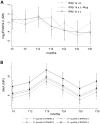MxA mRNA quantification and disability progression in interferon beta-treated multiple sclerosis patients
- PMID: 24733382
- PMCID: PMC3986392
- DOI: 10.1371/journal.pone.0094794
MxA mRNA quantification and disability progression in interferon beta-treated multiple sclerosis patients
Abstract
Even though anti-interferon beta (IFNβ) antibodies are the main determinants of IFNβ bioactivity loss and Myxovirus-resistance protein A (MxA) is the most established marker of IFNβ biological activity in IFNβ-treated multiple sclerosis patients, their usefulness in the routine clinical practice is still debated. Therefore, 118 multiple sclerosis patients naïve for treatment were enrolled for a 3-year longitudinal observational study mimicking the conditions of a real-world setting. In order to evaluate the kinetics of bioactivity loss in blood samples obtained every 6 months after therapy initiation, MxA and interferon receptor isoform/subunit mRNA were quantified by real-time PCR, anti-IFNβ binding antibodies were detected by radioimmunoprecipitation, and neutralizing antibodies by cytopathic effect inhibition assay. Clinical measures of disease activity and disability progression were also obtained at all time points. We found that, at the individual-patient level, the response to IFNβ therapy was extremely heterogeneous, including patients with stable or transitory, early or late loss of IFNβ bioactivity, and patients with samples lacking MxA mRNA induction in spite of absence of antibodies. No interferon receptor isoform alterations that could explain these findings were found. At the group level, none of these biological features correlated with the measures of clinical disease activity or progression. However, when MxA mRNA was evaluated not at the single time point as a dichotomic marker (induced vs. non-induced), but as the mean of its values measured over the 6-to-24 month period, the increasing average MxA predicted a decreasing risk of short-term disability progression, independently from the presence of relapses. Therefore, a more bioactive treatment, even if unable to suppress relapses, reduces their severity by an amount that is proportional to MxA levels. Together with its feasibility in the routine laboratory setting, these data warrant the quantification of MxA mRNA as a primary tool for a routine monitoring of IFNβ therapy.
Conflict of interest statement
Figures



Similar articles
-
Myxovirus Resistance Protein A mRNA Expression Kinetics in Multiple Sclerosis Patients Treated with IFNβ.PLoS One. 2017 Jan 12;12(1):e0169957. doi: 10.1371/journal.pone.0169957. eCollection 2017. PLoS One. 2017. PMID: 28081207 Free PMC article. Clinical Trial.
-
One-year evaluation of factors affecting the biological activity of interferon beta in multiple sclerosis patients.J Neurol. 2011 May;258(5):895-903. doi: 10.1007/s00415-010-5844-5. Epub 2010 Dec 12. J Neurol. 2011. PMID: 21153733 Clinical Trial.
-
MxA mRNA decrease preceding NAb detection in IFNβ-treated MS patients.Brain Behav. 2017 Feb 9;7(3):e00644. doi: 10.1002/brb3.644. eCollection 2017 Mar. Brain Behav. 2017. PMID: 28293479 Free PMC article.
-
Measurement of MxA mRNA or protein as a biomarker of IFNbeta bioactivity: detection of antibody-mediated decreased bioactivity (ADB).Neurology. 2003 Nov 11;61(9 Suppl 5):S24-6. doi: 10.1212/01.wnl.0000092361.04511.d0. Neurology. 2003. PMID: 14610107 Review.
-
Biological monitoring of IFN-β therapy in Multiple Sclerosis.Cytokine Growth Factor Rev. 2015 Apr;26(2):241-8. doi: 10.1016/j.cytogfr.2014.12.002. Epub 2014 Dec 24. Cytokine Growth Factor Rev. 2015. PMID: 25596967 Review.
Cited by
-
Myxovirus Resistance Protein A mRNA Expression Kinetics in Multiple Sclerosis Patients Treated with IFNβ.PLoS One. 2017 Jan 12;12(1):e0169957. doi: 10.1371/journal.pone.0169957. eCollection 2017. PLoS One. 2017. PMID: 28081207 Free PMC article. Clinical Trial.
-
Body fluid biomarkers for multiple sclerosis--the long road to clinical application.Nat Rev Neurol. 2015 Oct;11(10):585-96. doi: 10.1038/nrneurol.2015.173. Epub 2015 Sep 22. Nat Rev Neurol. 2015. PMID: 26392381 Review.
-
Absence of MxA induction is related to a poor clinical response to interferon beta treatment in multiple sclerosis patients.J Neurol. 2016 Apr;263(4):722-9. doi: 10.1007/s00415-016-8053-z. Epub 2016 Feb 12. J Neurol. 2016. PMID: 26872667
-
Predictors of Response to Multiple Sclerosis Therapeutics in Individual Patients.Drugs. 2016 Oct;76(15):1421-1445. doi: 10.1007/s40265-016-0639-3. Drugs. 2016. PMID: 27653757 Review.
-
Less Frequent and Less Severe Flu-Like Syndrome in Interferon Beta-1a Treated Multiple Sclerosis Patients with at Least One Allele Bearing the G>C Polymorphism at Position -174 of the IL-6 Promoter Gene.PLoS One. 2015 Aug 18;10(8):e0135441. doi: 10.1371/journal.pone.0135441. eCollection 2015. PLoS One. 2015. PMID: 26285213 Free PMC article.
References
-
- Rudick RA, Lee JC, Simon J, Ransohoff RM, Fisher E (2004) Defining interferon β response status in multiple sclerosis patients. Ann Neurol 56: 548–555. - PubMed
-
- Giacomini PS, Arnold DL, Bar-Or A, Antel JP (2009) Defining multiple sclerosis treatment response with magnetic resonance imaging: How much activity is too much? Arch Neurol 66: 19–20. - PubMed
-
- Río J, Comabella M, Montalban X (2009) Predicting responders to therapies for multiple sclerosis. Nat Rev Neurol 5: 553–560. - PubMed
-
- Killestein J, Polman CH (2011) Determinants of interferon β efficacy in patients with multiple sclerosis. Nat Rev Neurol 7: 221–228. - PubMed
Publication types
MeSH terms
Substances
LinkOut - more resources
Full Text Sources
Other Literature Sources
Medical

